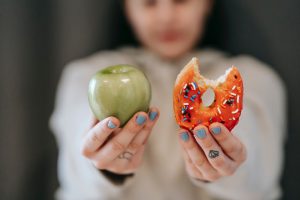Every time we eat a bunch of sugar or something that is high in carbohydrates we get a rush of glucose into our bloodstream which signals to our pancreas to release insulin to tell the cells to let the glucose in and signals to the liver to store the sugar and not make any more. What the glucose does is go to the cells to produce energy. Too much glucose suddenly in the bloodstream means our insulin can’t keep up or the cells become desensitised to the insulin and don’t respond. So with an intake of excessive sugar and carbs, the pancreas can’t keep up and leaves excess blood sugar in the bloodstream where it does lots of damage. Excessive and continuous blood sugar spikes result in glycation in the body – which is a fancy word for our cells being cooked by inflammation.
When this is continuously happening in the body, it results in accelerated aging of the body by loss of protein function and decreased elasticity in the skin, tendons and blood vessels. It also results in fat accumulating in the liver and elsewhere leading to weight gain and metabolic dysfunction. So it has a role in our increasing wrinkles, likelihood of injuring ourselves and risk of cardiovascular disease and weight gain as we age, whilst also making us age faster! The more we subject our bodies to those extreme glucose spikes, the more we increase the inflammation in our bodies. Short term we might notice symptoms such as acne, anxiety/depression, hormonal imbalances, weight gain, poor sleep and food cravings. Long term this looks like increased risk of metabolic issues such as diabetes, cardiovascular disease, accelerated ageing and neurodegenerative diseases such as Alzheimers.
How to know if you have some blood sugar dysregulation?
If you get symptoms like feeling tired after meals, a slump in the afternoon, feeling hangry or shaky in between meals (less than 4 hours), PMS, headaches, fatigue, sugar and food cravings or poor sleep especially waking through the night. These can all be indicators of having imbalanced blood sugar.
If we want to age well and reduce inflammation and chronic disease risk factors then it is essential that we look at how to keep our blood sugar balanced and reduce continuous glucose spikes. The best solution is to reduce sugar and processed foods where we can. Eating whole foods, lots of vegetables, sufficient protein and avoiding processed foods is a good starting point. If we are eating fruit and higher carb vegetables then pairing them with protein, fats and fibers can reduce glucose spikes.
Dietary and Lifestyle considerations
- Regular meals – ie skipping breakfast can be associated with prediabetes and increased insulin resistance.
- Protein, Fat & Fibre with meals (clothing your carbs)
- A plate of vegetables before all meals- especially carb heavy meals
- Vinegar before foods – a shot in water before meals can improve insulin sensitivity
- Movement after meals – 10 minute walk
- Eat a savoury breakfast instead of a sweet one
- Have fruit whole – not juiced or dried, add some nut butter for protein!
- Eat sweet foods at the end of a meal – never in the morning or on their own as a snack
- Regular exercise can help increase insulin sensitivity
- Managing stress with meditation and mindfulness
- Getting sufficient sleep

There are also several herbs and nutrients that can help with increasing blood sugar utilisation, improving insulin sensitivity and supporting the pancreas and liver. A nutritionist or naturopath will look at your case as an individual and will also be able to interpret pathology tests in order to give you the best treatment for you. They may prescribe certain herbs and supplements for a specific reason such as supporting mood or improving sleep so that you feel better and crave less sugary foods. Seeing a practitioner ensures that they look at your case as an individual and are able to tailor the treatment for your specific needs.

For references contact Gemma at gemmawellsnaturopathy@gmail.com
To book in for an appointment or find out more about Gemma follow this link.
